The Israel Antiquities Authority and The Western Wall Heritage Foundation made an important announcement today, reporting the discovery of the remains of a small Roman theatre or odeon in Jerusalem, just below Wilson’s Arch. This report includes a video in English. The Jerusalem Post also reports this find.
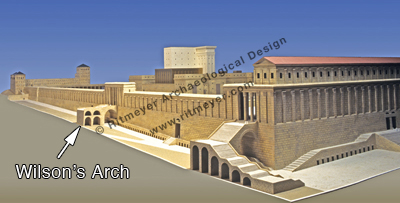
On the left of Robinson’s Arch is Barclay’s Gate with Wilson’s Arch at far left. The Temple towered high above the Temple Mount.
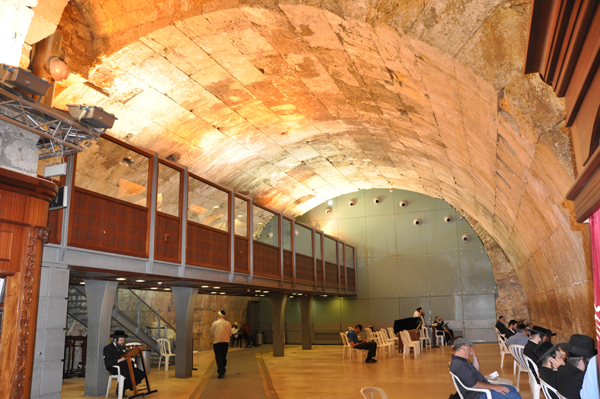
The discovery of the Roman odeon was made after removal of 8 meters of soil that exposed 8 stone courses of the Western Wall not previously seen:
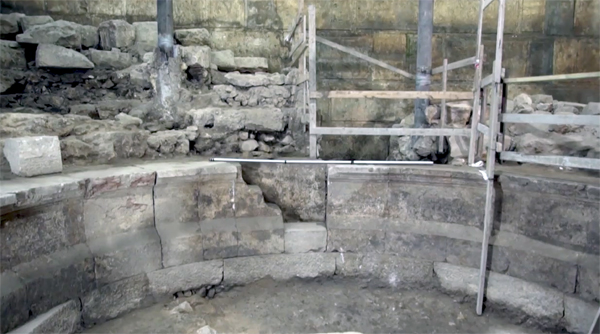
“After the removal of this layer of soil, the archaeologists were surprised to discover that it covered the remnants of an extraordinary theater-like structure from the Roman period confirming historical writings that describe a theater near the Temple Mount. These exciting findings will be presented to the public during a conference titled New Studies in the Archaeology of Jerusalem and its Environs, which will take place at the Hebrew University. This year’s conference will mark 50 years of archaeology since the unification of the city.”
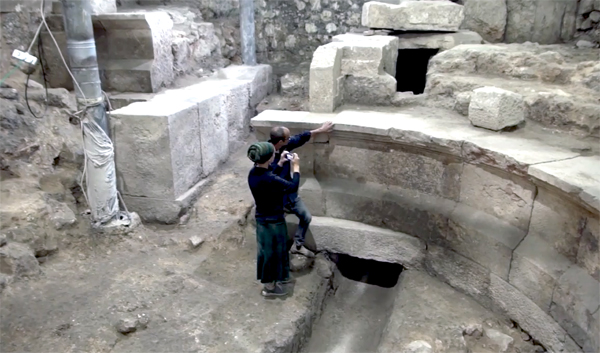 This odeon was not completed and was abandoned before it could be used. The excavators suggest that that may have been the result of the Jewish uprising against the Romans during the Bar Kokhba Revolt, a rebellion of the Jews of the Roman province of Judea, led by Simon bar Kokhba in circa 132–136 CE.
This odeon was not completed and was abandoned before it could be used. The excavators suggest that that may have been the result of the Jewish uprising against the Romans during the Bar Kokhba Revolt, a rebellion of the Jews of the Roman province of Judea, led by Simon bar Kokhba in circa 132–136 CE.
Because of its proximity to the Western Wall, this odeon could not have been very large, but its discovery provides us with a clearer picture of what Jerusalem looked like as the rebuilt Roman city of Aelia Capitolina.
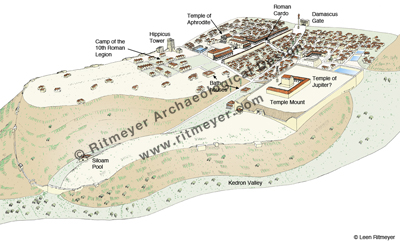
A word of caution: some reporters have dubbed this find “Jerusalem’s Lost Theatre”, but this may give the wrong impression. Josephus indeed mentions that Herod built a theatre in Jerusalem (Antiquities 15.268), but this is not the one that has been found. Herod’s theatre, if it ever existed, must have been built before 70 AD, but the archaeological evidence associated with this newly found structure indicates that it was built after this date.
HT: Joe Lauer

wasnt this the long searched for chamber of sanhedrin?
Eli,
No, it isn’t for this odeon was built after the Roman destruction of 70 CE.
odeon, but not a bouleuterion? It’s my understanding some structures served a dual purpose, but is there something about this one that says it did not?
It could be either, depending on what it was used for
LeHamechubad/To the HonorableDr Prof Ritmeyer.
This may be a little personal, I hope not. If it is I will be understandable if you do not let this post stand.
As a Jew who sees in you someone who has provided so much in terms of your studies and publications. Your sincere love of the land of Israel, where you have spent almost your whole life as an academic and researcher, trying to give the nation a lot of its history back, from defending the Temple grounds from shaky Theories as to where it stood , and finding unusual symbols above ground that nobody else would think twice about but you never let such thing pass, you wonder and ask why a particular lintel, jutting out of nowhere with nary a hint to its origins and you look for the reason for it being there.
Last word is that you dwell in Wales. What I wonder if I may be so bold, is why you have not settled in the land of Israel itself. Your love of the land, its history, a place where you spent so much of your life. Why would you not dwell in the land that you and the Missus have given so much of yourselves that automatic citizenship ought to be granted you without much ado. Personally, I’m betting that in your ancestral past there are Jews, I thought you were just based on your name when I first encountered your writings and publication. But even you be a Christian in the manner of the Jerusalem Church under James. I would think that there would be no place for you and your wife except the land that has meant so much in your life, both spiritually and earthly. And I bet you speak a good amount of Modern Hebrew amongst all other languages that you are versed in.
Again if I am too bold, please please do not take offense. But rather as a sign of the high regard I hold you and your wife, your helpmate in, that only is the land of Israel a fit dwelling for you.
Avi,
Thank you for asking. We indeed lived for many years in Jerusalem, married there and four of our five children were born in Jerusalem. They have Hebrew birth certificates. Although my wife Kathleen and I are Christians we do not belong to mainstream Christianity, but, as you suggest, to a group that identifies itself with the first century Jerusalem Church.
Not being Jewish, we were never granted permanent residence. The only way for us to stay in the country was as temporary residents, having to renew our ארעי status every year. We do read and speak Hebrew fluently and have taught Hebrew in Australia for several years.
We will always be Jerusalemites at heart, but are happy to live in Wales where we enjoy fellowship with like-minded believers and continue to work on the archaeology of Israel and visit the Land at least once a year to participate in excavations. We are glad that we have been able to contribute to the understanding of ancient sites, especially Jerusalem and its Temple Mount. We look upon it as a blessing from God and are glad that people like yourself find our research helpful.
Hello Leen Ritmeyer, I hope your well, for a couple of years ive been researching/reading the KJV bible and more recently The Ryrie Study Bible and online sources, although i am new to taking the word of God more seriously i would like to meet and speak with other Christians interested/following the “first century Jerusalem Church” and the true Sabbath . Shalom.
“Jerusalem Church under James” and “first century Jerusalem Church” ? Have you read The Tomb of James, Brother of Jesus, as Locus Memoriae by Yaron Z. Eliav ? It’s about The Temple Mount as a Sacred Cemetery.
In reference to your illustration of Roman Jerusalem [Aelia Capitolina], the area known as Mt Zion (even to Joesphus) is shown nearly bald.
St Epiphanius, later Bishop of Salamis (in Cyprus), was born in the Holy Land ca. 310, & resided there most of his life. He knew Jerusalem well; he reports that Titus did not destroy the homes on Mount Zion, nor did wicked Hadrian when suppressing the Second Jewish Revolt, in 135AD. As the Romans had no way to fund pensions for their veterans, the victors settled them on conquered lands; officers were given the finer homes – as we know happened in Emmaus [ha-Motza], to the extent that “Colonía” (Qoloniyeh) erased the ancient name unto recent years.
Is it plausible that the “little church” Epiphanius refers to, known as “Holy Zion, Mother of Churches” actually survived as a ‘house church’ prior to Byzantine rebuilding, about where the present Dormition Basilica stands?
Some references to 1st C. Mount Zion indicate that not only the High Priest’s home, but others of the House of Aaron were located there — palatial residences with “large upper rooms” — for the extended family gatherings at Passovertime.
If Elizabeth, mother of John Baptist, was ‘of the daughters of Aaron,’ & a relation of the Blessed Virgin Mary, might her home have been this one? Might it have been the very place JESUS & extended family kept the Passover when He was 12? If so, His relation with the owners would have been life-long!
I’m aware that Byzantine foundations of a church remain; but was any trace of the original home found below them?
Your illustration of Aelia Capitolina shows the area known as Mount Zion (even to Josephus) as nearly bald. Yet St Epiphanius of Salamis (in Cyprus) was born in the Holy Land, ca310AD, & lived there most of his life. He states that “the little church” (known as Holy Zion, Mother of Churches) had survived two destructions of Jerusalem! (He especially mentions the wicked Emp. Hadrian). Roman victors had no pensions for their veterans, so officers were often given nice homes that were emptied of their former residents.
I’m aware that Byzantine foundations of a basilican church were found ca 1982, right beside the Dormition Church, built ca 1910. Were any traces of a home found below these? The report on the 1982 dig, I’m told, has yet to be published! Thank you for any information.
Apart from some clay pipes that may have belonged to the Camp of the Tenth Legion, no substantial building remains of the immediate post-70AD period have been found on Mount Zion. Epiphanus lived in the Byzantine period and his description refers to that time, and not to that of Aelia Capitolina.
The Palace of Annas the High Priest has been located in the Jewish Quarter, not on Mount Zion. All the houses and palaces of Jerusalem were thoroughly destroyed by the Romans and therefore could not have been given as a “reward” to the Roman soldiers, as was possible in other places.
Both Elizabeth and Zecharias were descendants of Aaron the High Priest. They lived in a city of Juda, in the hill country (Luke 1:39). That is not Jerusalem, let alone Mount Zion. Aaron was given the city of Hebron, in the hill country of Judah (Joshua 21:11-13). Only Hebron qualifies as a “city in the Hill Country of Judah”, and that is where Mary visited Elisabeth (Luke 1:36.40).
Apart from some clay pipes that may have belonged to the Camp of the Tenth Legion, no substantial building remains of the immediate post-70AD period have been found on Mount Zion. Epiphanus lived in the Byzantine period and his description refers to that time, and not to that of Aelia Capitolina.
The Palace of Annas the High Priest has been located in the Jewish Quarter, not on Mount Zion. All the houses and palaces of Jerusalem were thoroughly destroyed by the Romans and therefore could not have been given as a “reward” to the Roman soldiers, as was possible in other places.
No Roman traces were found below the Byzantine foundations.